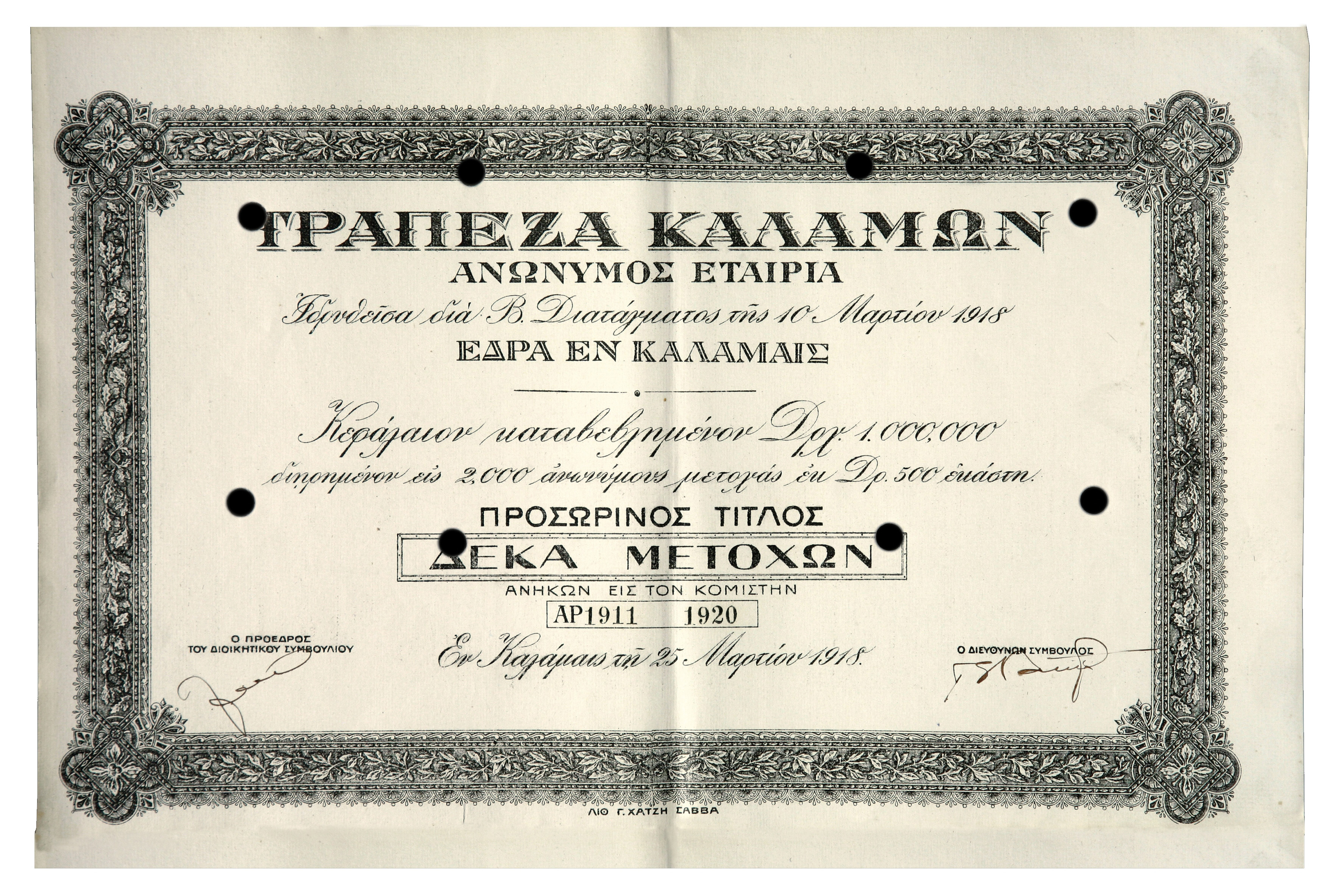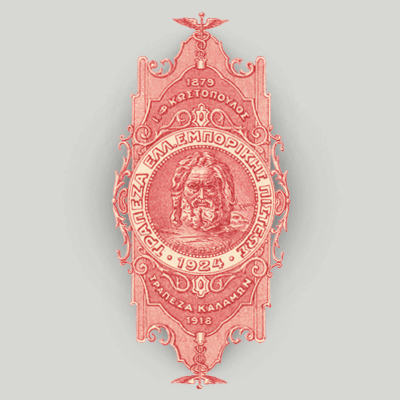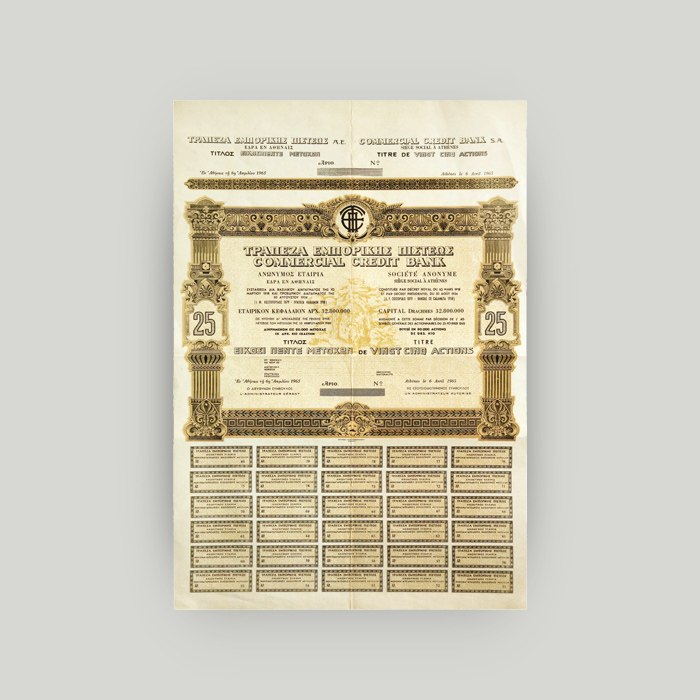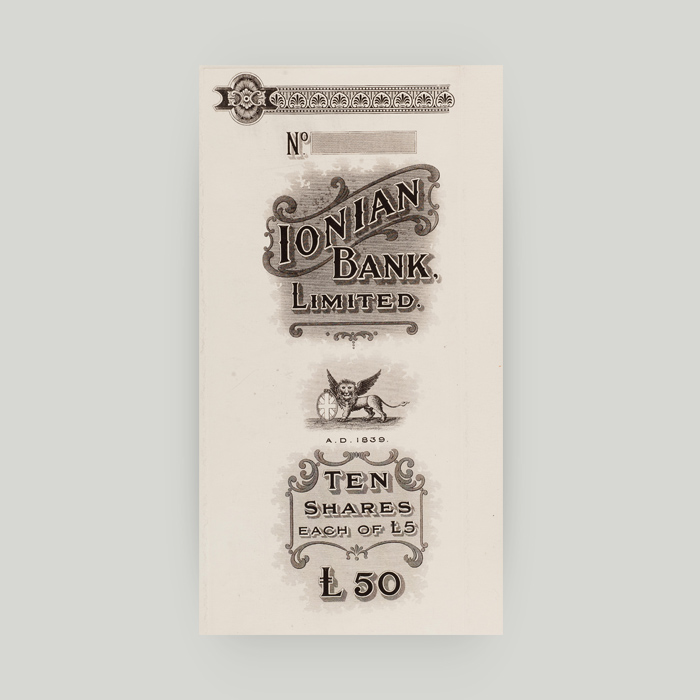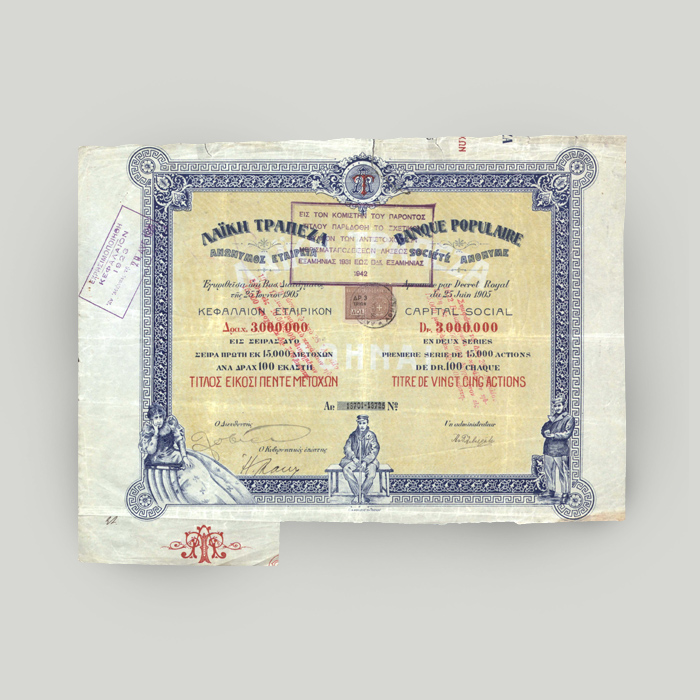Brief history of Kalamon Bank
Kalamon Bank (Bank of Kalamata) is one of very few banking institutions that grew out of smaller-scale, local banking businesses. Moving the headquarters to Athens was crucial for the bank’s course into the future. The Kalamon Bank 10-share temporary stock certificate from 1918 is elaborately decorated.
Kalamon Bank 10-share temporary paper stock certificate, issued in 1918.
The text at the top lists the bank’s name, headquarters location and year of establishment.
At the centre, the nominal share capital, the number of shares in total and the price of each share.
At the bottom, the number of shares in the certificate.
Densely-drawn plant motifs make up the border wrapping the text.
Just a local banking business
Kalamon Bank (Bank of Kalamata), present-day Alpha Bank, grew out of J. F. Costopoulos Bank.
It was founded on 14 March 1918 and was one of very few banking institutions that grew out of smaller-scale, local banking businesses.
Founder John F. Costopoulos would not live to see his vision fulfilled. He died soon after the establishment agreement was signed.
The new bank operated as an SA, following the same operation principles as its predecessor J. F. Costopoulos Bank.
It was a local bank for all intents and purposes, as clearly stated already in its first annual report.
An unusual operation scheme
Despite its markedly local profile, Kalamon Bank did not operate locally: all but 2 members of its Board of Directors were based in Athens. The Board convened in Athens, too.
Stylianidis, until then a Head of Department with Popular Bank, was appointed Director of the central branch at Kalamata.
Spyros Costopoulos was appointed Assistant Director, the same position he had held at the Patras temporary branch of Popular Bank until then.
Becoming established in the Kalamata market
Kalamon Bank tried to expand its client base and become established in the local market. Soon it was a force to be reckoned with when it came to attracting the significant deposits coming into the city’s banks mainly from the US.
The bank managed to fight off the competition by offering its clients more attractive service packages, including:
- Collateral with lower margins.
- Extended use of open accounts with just 1 signature.
Flourishing amid uncertainty
In 1919 exposure to loans with collateral in securities, especially insurance company securities, proved to be a problem. Despite this, Kalamon Bank remained on a steady growth path.
A year later, it was decided that the bank would operate an office in Athens. The office’s sole activity would be to check the bank’s monthly accounting statements and audit its operations.
In 1921 the Greek government established a foreign exchange union. The union would attempt to mitigate the sharp fluctuations in rates and secure the inflow of foreign exchange required to meet the country’s needs in food and military supplies. The bank participated in the union to the extent provided by law.
In 1923 Kalamon Bank opened another branch in Tripoli, Greece.
The first steps in Athens
The first branch in Athens opened in 1924 with Mimis Costopoulos as its Director. The branch was housed at the banking department of the J. F. Costopoulos commercial firm.
By initiative of Mimis Costopoulos, it was decided that Kalamon Bank and the firm’s banking department should merge.
The resulting banking institution was named Banque de Crédit Commercial Hellénique.
More information on Kalamon Bank is available in our publications:
- With Wisdom and Vision: ALPHA BANK, 19th – 21st Century, academic advisor: Kostas Kostis. The publication narrates the history of Alpha Bank, from founder J. F. Costopoulos’ first commercial ventures in the 19th century through to the present day. It also includes a wealth of unpublished photographic material, mainly from the Alpha Bank Historical Archives.
Buy the publication With Wisdom and Vision: ALPHA BANK, 19th – 21st Century on the Alpha Bank e-shop. - The Creators and the Creation of Banking Enterprises in Europe from the 18th to the 20th Century, edited by Kostas Kostis. The volume contains the proceedings of the academic meeting at the Old Fortress in Corfu on 5 and 6 October 2001 with contributions from distinguished economic historians.
Buy the publication The Creators and the Creation of Banking Enterprises in Europe from the 18th to the 20th Century on the Alpha Bank e-shop.
The Alpha Bank Historical Archives are not open to the public.
Research visits can be organised upon request.
Contact us to request a visit.
